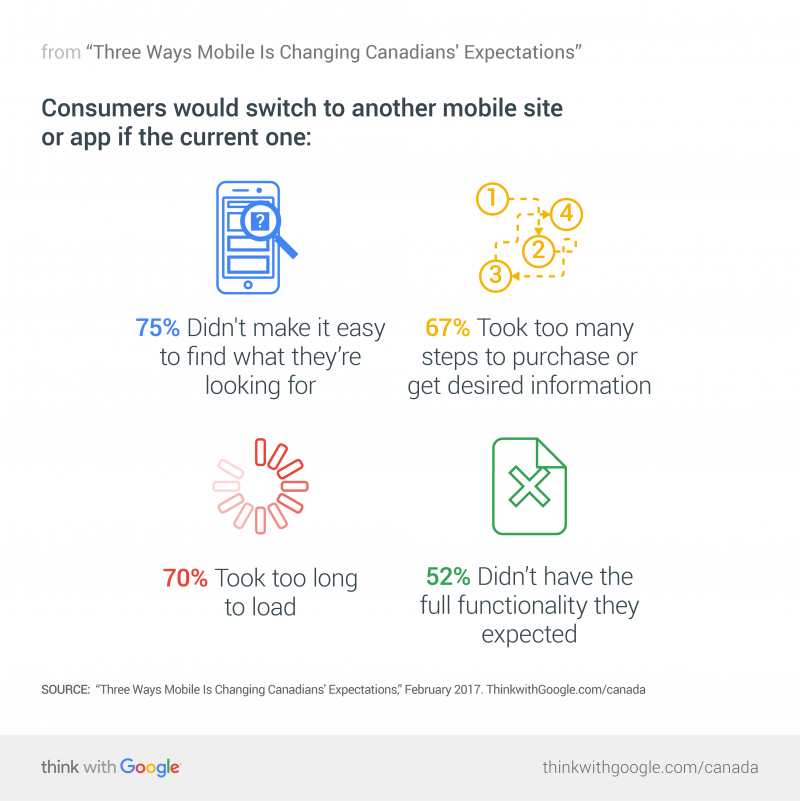
Three Ways Mobile Is Changing Canadians' Expectations
At this point, most Canadian brands have some presence on mobile. But it's not enough. Consumer expectations are higher than ever—and the sky's the limit for brands that can raise their game and provide delightful experiences in people’s moments of need.
Brands, take note: The bar for mobile experiences in Canada has been raised.
Now that consumers can use their smartphones to do things like turn up their home's thermostat from their car, book flights without leaving Google assistant, and e-transfer money to their dog walkers, they have come to expect seamless—even delightful—solutions for everything they want to do on mobile.
More than half (55%) of Canadian smartphone owners expect a mobile app or mobile website to work as well as a site they can use on their computer.1 And considering that 72% of Canadian smartphone users expect to get immediate information while using their smartphones,2 consumers demand helpful information and fast load times in their moments of need.
Striving to provide delightful experiences on mobile can be hugely transformational for brands, especially as smartphones increasingly becomes people's primary computing devices: 26% of laptops or desktops currently owned in Canada won't be replaced when they no longer work.3 And that number goes up to 35% of laptops or desktops currently owned among 18–24 year olds.3
The mobile opportunity is still largely untapped in Canada. Having a mobile-optimized site and investing in mobile ads is not enough—sites are underdeveloped and experiences aren't up to what people expect. The solution starts with rethinking your customer's entire experience with mobile in mind. When you put the user at the centre of everything you do, you can solve bigger problems for people and find ways to meet their needs in each moment.
To help you deliver on what Canadians expect, we asked consumers what is most important on mobile. They told us they want brands to deliver convenience, helpful solutions, and fast answers.
Convenience: Provide what people want, when they want it
Start by thinking about what your customers might need in any given moment and how to get it to them quicker. How can you reduce steps, clicks, and redirects?
In some cases, it's about reducing physical steps. If Canadians know what kind of book, light fixture, or sunglasses they need, for example, most don't want to have to stop by the store to see if it's available. Sixty-six percent of consumers expect to see online what stores nearby have the item they want in stock.1
Instead of starting from your current functionality or capabilities, think of how you can delight and surprise customers. Maybe mobile ordering is the most important thing to your customers—or maybe they just need to be able to find you quickly. A great example of this is a Dunkin' Donuts campaign in New York City. Dunkin' Donuts knew that at 8:00 a.m., customers want to get their coffee ASAP. Instead of building a mobile ordering app, the brand used mobile search to respond to customers searching for “coffee near me.” Caffeine-deficient customers could see real-time walk and line-wait times for nearby locations and head right to the store.
Helpful solutions: Make consumers' lives easier
A lot of what consumers have come to rely on today they didn't even know was possible until they had it. Now Canadians expect to have their needs met—and anticipated—on mobile. For example, 44% of smartphone owners expect brands to send notifications to their phones when a product they're interested in goes on sale.4
Red Roof Inn designed its mobile experience to meet stranded travellers' needs in the moment. Wherever there was a cancelled flight at an airport with a Red Roof Inn nearby, the brand bid up on the mobile search so it would place first. It also used custom text to reference the delayed plane, and location formats to show how close the nearest Red Roof Inn was. The mobile site was simple and had everything a stranded traveller would need quickly. Red Roof saw a remarkable 60% increase in bookings from this campaign.
Think of all the things you can do to make people's lives easier in big and little ways. For example, we know that more than half of smartphone owners prefer to shop on a retailer's mobile site or app that allows them to save their product preferences.4 Even simple things that save people some time can go a long way toward giving them seamless experiences.
Fast answers: Remove any barriers
All the amazing experiences available at our fingertips have made consumers pretty impatient. Right now, 34% of Canadian smartphone owners expect to search or purchase something on their smartphones faster than on their computer.2 Food delivery brands, in particular, are constantly looking for ways to remove anything that would get between hungry Canadians and their cravings. With features like one-click or zero-click ordering, consumers are finding it easier than ever to curb their cravings just by opening an app.
In a similar vein, we asked respondents what might make them immediately switch to another company's mobile site or app:2

Consumers will move on quickly if they can't get what they need, but brands can prevent those wandering eyes by providing seamless, fast mobile experiences.
Delightful mobile experiences will win the day
Instead of looking at what your peers in the industry are doing, tackle mobile by thinking through what your customers need every step along the way. Having a mobile presence is only part of it—find ways to solve bigger problems, transform user engagement, and give people more control.
These high expectations may seem daunting, but they're also reflective of hugely exciting opportunities for Canadian businesses and brands. Consumers are often more loyal to their needs in the moment than they are to a specific brand, which means that brands that get out there first and provide delightful experiences are the ones that will win the day.
